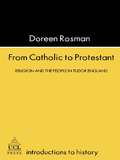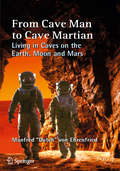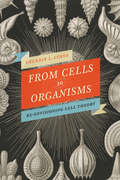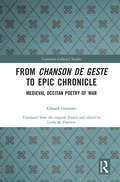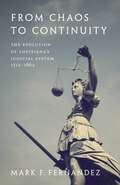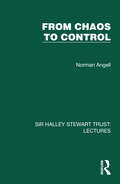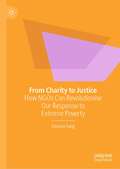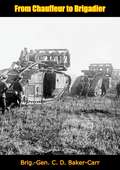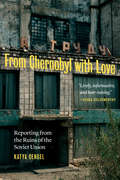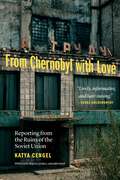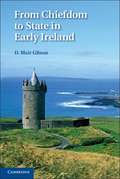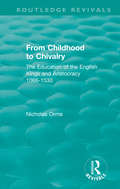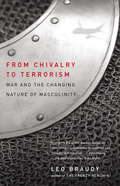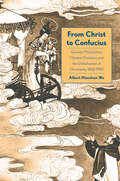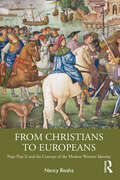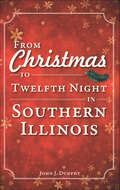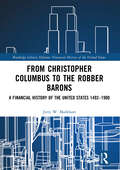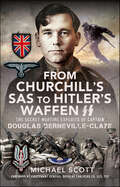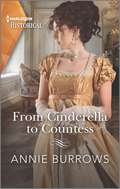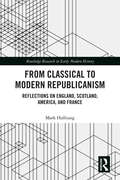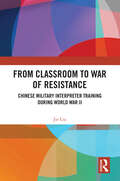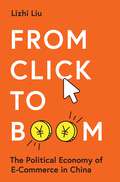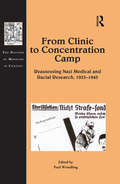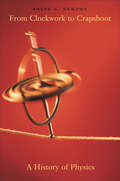- Table View
- List View
From Catholic To Protestant: Religion and the People in Tudor and Stuart England (Introductions To History Ser.)
by Doreen Margaret RosmanFirst published in 1996. Routledge is an imprint of Taylor & Francis, an informa company.
From Cave Art to Hubble: A History of Astronomical Record Keeping (Astronomers' Universe)
by Jonathan PowellSince ancient times, humans have been engaged in a continual quest to find meaning in and make sense of sights and events in the night sky. Cultures spread around the world recorded their earliest efforts in artwork made directly on the natural landscapes around them, and from there they developed more and more sophisticated techniques for observing and documenting astronomy.This book brings readers on an astronomical journey through the ages, offering a history of how our species has recorded and interpreted the night sky over time. From cave art to parchment scribe to modern X-ray mapping of the sky, it chronicles the ever-quickening development of tools that informed and at times entirely toppled our understanding of the natural world.Our documentation and recording techniques formed the bedrock for increasingly complex forays into astronomy and celestial mechanics, which are addressed within these chapters. Additionally, the book explores how nature itself has recorded the skies in its own way, which can be unraveled through ongoing geological and archaeological studies. This tale of human discovery and ingenuity over the ages will appeal to anybody interested in the field of astronomy and its rich cultural history.
From Cave Man to Cave Martian: Living in Caves on the Earth, Moon and Mars (Springer Praxis Books)
by Manfred "Dutch" von EhrenfriedThis book explores the practicality of using the existing subsurface geology on the Moon and Mars for protection against radiation, thermal extremes, micrometeorites and dust storms rather than building surface habitats at great expense at least for those first few missions. It encourages NASA to plan a precursor mission using this concept and employ a “Short Stay” Opposition Class mission to Mars as the first mission rather than the “Long Stay” concept requiring a mission that is too long, too dangerous and too costly for man’s first missions to Mars.Included in these pages is a short history on the uses of caves by early humans over great periods of time. It then describes the ongoing efforts to research caves, pits, tunnels, lava tubes, skylights and the associated technologies that pertain to potential lunar and Mars exploration and habitation. It describes evidence for existing caves and lava tubes on both the Moon and Mars. The work of noted scientists, technologists and roboticists are referenced and described. This ongoing work is moreextensive than one would think and is directly applicable to longer term habitation and exploration of the Moon and Mars. Emphasis is also given to the operational aspects of working and living in lunar and Martian caves and lava tubes.
From Cells to Organisms: Re-envisioning Cell Theory
by Sherrie L LyonsMore than a history, From Cells to Organisms delves into the nature of scientific practice, showing that results are interpreted not only through the lens of a microscope, but also through the lens of particular ideas and prior philosophical convictions. Before the twentieth century, heredity and development were considered complementary aspects of the fundamental problem of generation, but later they became distinct disciplines with the rise of genetics. Focusing on how cell theory shaped investigations of development, this book explores evolution, vitalism, the role of the nucleus, and the concept of biological individuality. Building upon the work of Thomas Huxley, an important early critic of cell theory, and more recent research from biologists such as Daniel Mazia, From Cells to Organisms covers ongoing debates around cell theory and uses case studies to examine the nature of scientific practice, the role of prestige, and the dynamics of theory change.
From Chanson de Geste to Epic Chronicle: Medieval Occitan Poetry of War (Variorum Collected Studies)
by Gérard GouiranIn this collection of essays Gérard Gouiran, one of the world's leading and much-loved scholars of medieval Occitan literature, examines this literature from a primarily historical perspective. Through texts offering hitherto unexplored insights into the history and culture of medieval Europe, he studies topics such as the representation of alterity through female figures and Saracens in opposition to the ideal of the Christian knight; the ways in which the narrating of history can become resistance and propaganda discourse in the clash between the Catholic Church and the French on the one hand, and the Cathar heretics and the people of Occitania on the other; questions of intertextuality and intercultural relations; cultural representations fashioning the West in contact with the East; and Christian dissidence in the twelfth and thirteenth centuries. Written in an approachable style, the book will be of historical, literary and philological interest to scholars and students, as well as any reader curious about this hitherto little-known Occitan literature.
From Chaos to Continuity: The Evolution of Louisiana's Judicial System, 1712–1862
by Mark FernandezHistorians have long viewed Louisiana as an anomaly in the American judicial system-an eccentric appendage at the mouth of the Mississippi River. The diverse Creole culture and civilian heritage of the state's legal system have led many scholars to conclude that it is an anachronism in American law unworthy of serious attention. Others embrace this tradition and revel in the minutiae of the Pelican State's unique civil law legacy. In From Chaos to Continuity, Mark F. Fernandez challenges both perspectives. Using the innovative methods of the New Louisiana Legal History, he offers the first comprehensive analysis of the role of the courts in the development of Louisiana's legal system and convincingly argues that the state is actually a representative model of American law and justice. Tracing the rise of Louisiana's system from its earliest colonial origins to its closure during Federal occupation in 1862, Fernandez describes the introduction of common law after American takeover of the colony; the chaotic combination of French, Spanish, and Anglo legal traditions; the evolution of that jurisdiction; the role of the courts-especially the state supreme court-in maintaining the mixture; and the judge's proper function in administering justice. According to Fernandez, the challenge of integrating two very different systems of law was not unique to Louisiana. Indeed, most antebellum southern states had legal systems that incorporated important traditional aspects of their colonial legal orders to varying degrees. From Chaos to Continuity liberates Louisiana's legal history from the quirky restraints of the past and allows scholars and students alike to see the state as an integral part of American legal history.
From Chaos to Control (Sir Halley Stewart Trust: Lectures)
by Norman AngellOriginally published in 1933, this volume From Chaos to Control represents the expansion of notes used in the delivery of the Halley Stewart Lectures for 1932–1933. Following on from the economic lecture of the previous year, this title covers “the psychology of popular understanding, of the nature of the public mind in relation to the technical problems discussed by last year’s lecturers; a problem of education, of politics.”This book is a re-issue originally published in 1933. The language used and views portrayed are a reflection of its era and no offence is meant by the Publishers to any reader by this re-publication.
From Charity to Justice: How NGOs Can Revolutionise Our Response to Extreme Poverty
by Vincent FangThis book focuses on the ethical demands of extreme poverty and develops a political theory of practical change. Welding together political realism and moral aspirations, it argues that a re-imagined form of development NGO can help the global North break free from the dominant and persistent charity paradigm and drift towards a justice-based understanding of extreme poverty. It offers an original explanation of why the charity paradigm persists and why the “justice not charity” messages from development NGOs have changed few minds. The author argues that anyone concerned with a paradigm shift from charity to justice need to radically rethink the problem of political communication: who should communicate what messages about extreme poverty in what ways? Based on a rational choice critique of the competitive development NGO sector, the author calls for sector-wide reform and the emergence of a new political agent – the Avant-garde NGO - which transcends the charity frame that NGOs currently find themselves locked in. Further, inspired by literary theory and social psychology, he offers a fresh account of how the Avant-garde NGO could, through reflective public engagement, induce attitude change and lead genuine social and political reform.
From Chauffeur to Brigadier
by Brig.-Gen. C. D. Baker-CarrOriginally published in 1930, these are the remarkable memoirs of Brigadier General Christopher D'Arcy Bloomfield Saltern Baker-Carr (1878-1949), a British Army staff officer who went on to rise through the ranks to become an important military commander during World War I.His account begins in August 1914 with his departure for the front in France and concludes four years later with his experiences at his last headquarters, situated in a small town in northern France, Caudry.“It was my unique privilege during the Great War to be closely associated with the development and organisation of the most important defensive weapon, the machine gun, and of the most important offensive weapon, the tank.“Today, perhaps, it will seem incredible that the High Command failed to appreciate the true value of the machine gun and the tank in the early stages of their development. It will seem even more incredible that, at a later period, it was necessary to scheme and struggle against official lukewarmness, at times almost indistinguishable from hostility, in order to secure the increase in the numbers of these arms, which, as was evident to everybody else, had proved themselves to be the greatest preservers of life yet discovered.“In the following pages I have endeavoured to set down an account of the difficulties encountered, of failures and successes, of high hopes brought to the ground by lack of faith and vision, of the ultimate recognition at long last, of the superiority of machinery and metal over beef and brawn.“Much of what I have written, especially in the earlier portions of the book, is, of necessity, a personal narrative, and I have described events and occurrences as I, myself, saw them.”—Brig.-Gen. C. D. Baker-Carr
From Chernobyl with Love: Reporting from the Ruins of the Soviet Union
by Katya CengelIn the wake of the fall of the Berlin Wall, the late twentieth century was a time of unprecedented hope for democracy and freedom in Eastern Europe. The collapse of the Soviet Union left in its wake a number of independent countries where the Scorpions’ 1990 pop ballad “Wind of Change” became a rallying cry. Communist propaganda was finally being displaced by Western ideals of a free press. Less than two decades ago, young writers, journalists, and adventurers such as Katya Cengel flocked from the West eastward to cities like Prague and Budapest, seeking out terra nova. Despite the region’s appeal, neither Kyiv in the Ukraine nor Riga in Latvia was the type of place you would expect to find a twenty-two-year-old Californian just out of college. Kyiv was too close to Moscow. Riga was too small to matter—and too cold. But Cengel ended up living and working in both. This book is her remarkable story. Cengel first took a job at the Baltic Times just seven years after Latvia regained its independence. The idea of a free press in the Eastern Bloc was still so promising that she ultimately moved to the Ukraine. From there Cengel made several trips to Chernobyl, site of the world’s worst nuclear disaster. It was at Chernobyl that she met her fiancé, but as she fell in love, the Ukraine collapsed into what would become the Orange Revolution, bringing it to the brink of political disintegration and civil war. Ultimately, this fall of idealism in the East underscores Cengel’s own loss of innocence. From Chernobyl with Love is an indelible portrait of this historical epoch and a memoir of the highest order.
From Chernobyl with Love: Reporting from the Ruins of the Soviet Union
by Katya Cengel2019 Foreword INDIES Award, Gold for Autobiography & Memoir Bronze Medal winner in the Independent Book Publishers Awards In the wake of the fall of the Berlin Wall, the late twentieth century was a time of unprecedented hope for democracy and freedom in Eastern Europe. The collapse of the Soviet Union left in its wake a number of independent countries where the Scorpions&’ 1990 pop ballad &“Wind of Change&” became a rallying cry. Communist propaganda was finally being displaced by Western ideals of a free press. Less than two decades ago, young writers, journalists, and adventurers such as Katya Cengel flocked from the West eastward to cities like Prague and Budapest, seeking out terra nova. Despite the region&’s appeal, neither Kyiv in the Ukraine nor Riga in Latvia was the type of place you would expect to find a twenty-two-year-old Californian just out of college. Kyiv was too close to Moscow. Riga was too small to matter—and too cold. But Cengel ended up living and working in both. This book is her remarkable story. Cengel first took a job at the Baltic Times just seven years after Latvia regained its independence. The idea of a free press in the Eastern Bloc was still so promising that she ultimately moved to the Ukraine. From there Cengel made several trips to Chernobyl, site of the world&’s worst nuclear disaster. It was at Chernobyl that she met her fiancé, but as she fell in love, the Ukraine collapsed into what would become the Orange Revolution, bringing it to the brink of political disintegration and civil war. Ultimately, this fall of idealism in the East underscores Cengel&’s own loss of innocence. From Chernobyl with Love is an indelible portrait of this historical epoch and a memoir of the highest order.
From Chiefdom to State in Early Ireland
by D. Blair GibsonThis book tracks the development of social complexity in Ireland from the late prehistoric period on into the Middle Ages. Using a range of methods and techniques, particularly data from settlement patterns, Blair Gibson demonstrates how Ireland evolved from constellations of chiefdoms into a political entity bearing the characteristics of a rudimentary state. This book argues that early medieval Ireland's highly complex political systems should be viewed as amalgams of chiefdoms with democratic procedures for choosing leaders rather than kingdoms. Gibson explores how these chiefdom confederacies eventually transformed into recognizable states over a period of 1,400 years.
From Childhood to Chivalry: The Education of the English Kings and Aristocracy 1066-1530 (Routledge Revivals)
by Nicholas OrmeOriginally published in 1984, this is a study of the kings and the aristocracy who ruled England between the Conquest and the Reformation. Not, as usual, about their adult lives, but how they became the people they were through childhood and education. The first such study of its kind, it follows noble boys and girls from birth through the care of their nurses, masters and mistresses, until they left home for further training in noble households, monasteries and universities. The author examines the theories and treatises on noble education, again for the first time. The rest of the book broadens into a wide cultural survey as Dr Orme describes the skills and ideas which noble children learnt. He explains how they mastered speech and literacy; worship and behaviour; dancing, music and applied art; athletics and training for war. This part of the study is a handbook of noble pursuits in medieval times. In his final chapter the author considers the nature of noble education in the middles ages, and examines how and whether it changed at the Renaissance. Nicholas Orme has written a comprehensive study, spanning 450 years of English history and making a major contribution to social and cultural history, as well as the history of education. His book will be invaluable to historians and medievalists of all disciplines, and essential reading from those who study the Renaissance.
From Chivalry to Terrorism: War and the Changing Nature of Masculinity
by Leo BraudyManliness has always been linked to physical prowess and to war; indeed the warrior has been the archetypal man across countless cultures throughout time. In this magisterial excursion through literature, history, warfare, and sociology, one of our most prominent scholars tracks the complex relationship between the changing methods and goals of warfare and shifting models of manhood. This journey takes us from the citizen soldiers of ancient Greece to the medieval knights to the misogynistic terrorists of Al Qaeda. As he chronicles these transformations, Leo Braudy weighs the significance of everything from weapon technology to the hairstyles favored during different eras. He offers fresh insights on codes of war and codes of racial purity, and on cultural and historical figures from Socrates to Don Quixote to Napoleon to Custer to Rambo. Epic in scope and free of academic jargon,From Chivalry to Terrorismis a masterwork of scholarship that is both accessible and breathtakingly ambitious.
From Christ to Confucius: German Missionaries, Chinese Christians, and the Globalization of Christianity, 1860-1950
by Albert Monshan WuIn this accessibly written and empirically based study, Albert Wu documents how German missionaries—chastened by their failure to convert Chinese people to Christianity—reconsidered their attitudes toward Chinese culture and Confucianism. In time, their increased openness catalyzed a revolution in thinking among European Christians about the nature of Christianity itself. At a moment when Europe’s Christian population is falling behind those of South America and Africa, Wu’s provocative analysis sheds light on the roots of Christianity’s global shift.
From Christians to Europeans: Pope Pius II and the Concept of the Modern Western Identity
by Nancy BisahaProviding the first in-depth examination of Pope Pius II’s development of the concept of Europe and what it meant to be ‘European’, From Christians to Europeans charts his life and work from his early years as a secretary in Northern Europe to his papacy. This volume introduces students and scholars to the concept of Europe by an important and influential early thinker. It also provides Renaissance specialists who already know him with the fullest consideration to date of how and why Pius (1405–1464) constructed the idea of a unified European culture, society, and identity. Author Nancy Bisaha shows how Pius’s years of travel, his emotional response to the fall of Constantinople in 1453, and the impact of classical ethnography and other works shaped this compelling vision—with close readings of his letters, orations, histories, autobiography, and other works. Europeans, as Pius boldly defined them, shared a distinct character that made them superior to the inhabitants of other continents. The reverberations of his views can still be felt today in debates about identity, ethnicity, race, and belonging in Europe and more generally. This study explores the formation of this problematic notion of privilege and separation—centuries before the modern era, where most scholars have erroneously placed its origins. From Christians to Europeans adds substantially to our understanding of the Renaissance as a critical time of European self-fashioning and the creation of a modern "Western" identity. This book is essential reading for students and scholars interested in the formation of modern Europe, intellectual history, cultural studies, and the history of Renaissance Europe, late medieval Italy, and the Ottoman Empire.
From Christmas to Twelfth Night in Southern Illinois
by John J. DunphyJourney to a region where all the perennials are said to bloom at midnight on Christmas Eve and where a family's luck is determined by the first person to walk through their door on New Year's Day. Spend a literary Christmas in Herrin, listen to the twelve bells of Belleville ring out the coming year and greet the Three Kings of Germantown at Epiphany. Whether you are a newcomer to southern Illinois or whether you feel like you have been singing "La Guiannee" since the tradition started in Prairie du Rocher in 1720, join John J. Dunphy for a season of sacred memories and merry recollections.
From Christopher Columbus to the Robber Barons: A Financial History of the United States 1492–1900 (Financial History of the United States)
by Jerry W. MarkhamOriginally published in 2002, this is the first of three volumes in a history of finance in America. This volume covers the period from the 'discovery' of America to the end of the nineteenth century. It describes the status of finance in Europe at the time of Christopher Columbus' voyage to America. It then traces its transfer and development in America through the Revolution, into the Civil War and beyond to the speculative excesses occurring after that event.
From Churchill's SAS to Hitler's Waffen-SS: The Secret Wartime Exploits of Captain Douglas Berneville-Claye
by Michael Scott"Thoroughly researched and well written, this book astounds the reader as to how its subject managed to get away with all the things he did. The author tells a good story about a bad man and his wartime escapades." —WWII History MagazineCaptain Douglas Berneville-Claye was serving with the fledgling SAS with fellow officers such as David Stirling and Blair ‘Paddy’ Mayne when he was captured in the Western Desert. He was ‘turned’ and became a member of the Nazi Waffen-SS. Collaboration with the enemy was confirmed when dressed as an SS captain he approached remnants of the British Free Corps; the Waffen-SS unit composed of renegade British nationals. He exhorted them to serve under his command against Russian forces. Post-war Berneville-Claye was investigated by MI5 for treachery. Following an Army court-martial he was dishonorably dismissed and sentenced to six months imprisonment. Upon release, his escapades and private life were no less contentious. A philanderer and bigamist, he married four times, sired ten children and rubbed shoulders with the criminal underworld in and out of prison. Eventually he succeeded in emigrating to Australia. Thanks to the author’s painstaking research, this is a compelling yet shocking biography of one of the most intriguing, colorful and disreputable characters of his era. How he escaped with his life is a question readers will ponder.
From Cinderella to Countess: A Regency Historical Romance
by Annie BurrowsFrom Cinderella in the shadowsTo countess in the spotlight?Lady’s companion Eleanor Mitcham longs to escape her unhappy life. Having been told she’s too lowly to speak to Lord Lavenham, Eleanor defiantly accepts his challenge to teach her employer a lesson—by marrying him! He is an eligible earl after all. However, his determinedly cynical view of marriage makes her dissolve their convenient betrothal and flee, leaving the drama of the household behind…and Lord Lavenham hot on her heels!“From the beginning it was a riveting read - I was unable to put it down. It was a fun and sweet tale.” —Elodie is Reading on A Marquess, A Miss and a Mystery“A great book, told with a lot of heart and feeling. The characters are well drawn and you can’t help but fall in love with them.” —Sanoobar Unscripted on A Duke in Need of a Wife
From Classical to Modern Republicanism: Reflections on England, Scotland, America, and France
by Mark HulliungIn 1955 Louis Hartz published a volume titled The Liberal Tradition in America, in which he argued that liberalism was the one and only American tradition. Since then scholars of New Left and neoconservative persuasion have offered an alternative account based on the notion that the civic notions of antiquity continued to dominate political thought in modern times. Against this revisionist view the argument of From Classical to Modern Liberalism is that we need to study America in comparative perspective, and if we do so we shall discover that republicanism in the modern world was distinctively modern, drawing upon ideas of natural rights, consent, and social contract. Rather than a struggle between liberalism and republicanism, we should speak about liberal republicanism. Rather than republicanism versus liberalism, we should address liberalism versus illiberalism, the true issue of our age.
From Classroom to War of Resistance: Chinese Military Interpreter Training during World War II
by Jie LiuThis book focuses on a long- neglected yet important topic in China’s translation history: interpreter/ translator training and wartime translation studies. It examines the military interpreter training programmes after the outbreak of the Pacific War (1941–1945), further revealing the indispensable role of translation and interpreting in war. The author explores the relationship between linguistic education and war context in the China- Burma- India Theatre, where international cooperation was salient. Some 4,000 interpreting officers played a vital role in assisting in air defence, transportation, training of the Chinese army and coordinating expeditionary operations. The book seeks to bring these interpreters to life, telling the stories of why they joined the war, how they were trained and what they did in the war. Through the study of training programmes, historical archives, accounts and trainees’ memoirs, discussions revolve around key strands of education, including curriculums, textbooks and training methods. Utilising foreign language education practices as its main case study, the book analyses these through the framework of linguistic and translation theories. The book contributes to Chinese interpreting history by exploring its first-ever nationwide professional interpreting (and translation) training practices, and will inspire scholars of translation/ interpreting training, world modernhistory and foreign language education in general.
From Click to Boom: The Political Economy of E-Commerce in China (Princeton Studies in Contemporary China)
by Lizhi LiuHow the world&’s largest e-commerce market highlights a digital path to developmentHow do states build vital institutions for market development? Too often, governments confront technical or political barriers to providing the rule of law, contract enforcement, and loan access. In From Click to Boom, Lizhi Liu examines a digital solution: governments strategically outsourcing tasks of institutional development and enforcement to digital platforms—a process she calls &“institutional outsourcing.&”China&’s e-commerce boom showcases this digital path to development. In merely two decades, China built from scratch a two-trillion-dollar e-commerce market, with 800 million users, seventy million jobs, and nearly fifty percent of global online retail sales. Contrary to conventional wisdom, Liu argues, this market boom occurred because of weak government institutions, not despite them. Gaps in government institutions compelled e-commerce platforms to build powerful private institutions for contract enforcement, fraud detection, and dispute resolution. For a surprisingly long period, the authoritarian government acquiesced, endorsed, and even partnered with this private institutional building despite its disruptive nature. Drawing on a plethora of interviews, original surveys, proprietary data, and a field experiment, Liu shows that the resulting e-commerce boom had far-reaching effects on China.Institutional outsourcing nonetheless harbors its own challenges. With inadequate regulation, platforms may abuse market power, while excessive regulation stifles institutional innovation. China&’s regulatory oscillations toward platforms—from laissez-faire to crackdown and back to support—underscore the struggle to strike the right balance.
From Clinic to Concentration Camp: Reassessing Nazi Medical and Racial Research, 1933-1945 (The History of Medicine in Context)
by Paul WeindlingRepresenting a new wave of research and analysis on Nazi human experiments and coerced research, the chapters in this volume deliberately break from a top-down history limited to concentration camp experiments under the control of Himmler and the SS. Instead the collection positions extreme experiments (where research subjects were taken to the point of death) within a far wider spectrum of abusive coerced research. The book considers the experiments not in isolation but as integrated within wider aspects of medical provision as it became caught up in the Nazi war economy, revealing that researchers were opportunistic and retained considerable autonomy. The sacrifice of so many prisoners, patients and otherwise healthy people rounded up as detainees raises important issues about the identities of the research subjects: who were they, how did they feel, how many research subjects were there and how many survived? This underworld of the victims of the elite science of German medical institutes and clinics has until now remained a marginal historical concern. Jews were a target group, but so were gypsies/Sinti and Roma, the mentally ill, prisoners of war and partisans. By exploring when and in what numbers scientists selected one group rather than another, the book provides an important record of the research subjects having agency, reconstructing responses and experiential narratives, and recording how these experiments – iconic of extreme racial torture – represent one of the worst excesses of Nazism.
From Clockwork to Crapshoot: A History of Physics
by Roger G. NewtonScience is about 6000 years old while physics emerged as a distinct branch some 2500 years ago. As scientists discovered virtually countless facts about the world during this great span of time, the manner in which they explained the underlying structure of that world underwent a philosophical evolution. From Clockwork to Crapshoot provides the perspective needed to understand contemporary developments in physics in relation to philosophical traditions as far back as ancient Greece. Roger Newton, whose previous works have been widely praised for erudition and accessibility, presents a history of physics from the early beginning to our day--with the associated mathematics, astronomy, and chemistry. Along the way, he gives brief explanations of the scientific concepts at issue, biographical thumbnail sketches of the protagonists, and descriptions of the changing instruments that enabled scientists to make their discoveries. He traces a profound change from a deterministic explanation of the world--accepted at least since the time of the ancient Greek and Taoist Chinese civilizations--to the notion of probability, enshrined as the very basis of science with the quantum revolution at the beginning of the twentieth century. With this change, Newton finds another fundamental shift in the focus of physicists--from the cause of dynamics or motion to the basic structure of the world. His work identifies what may well be the defining characteristic of physics in the twenty-first century.
